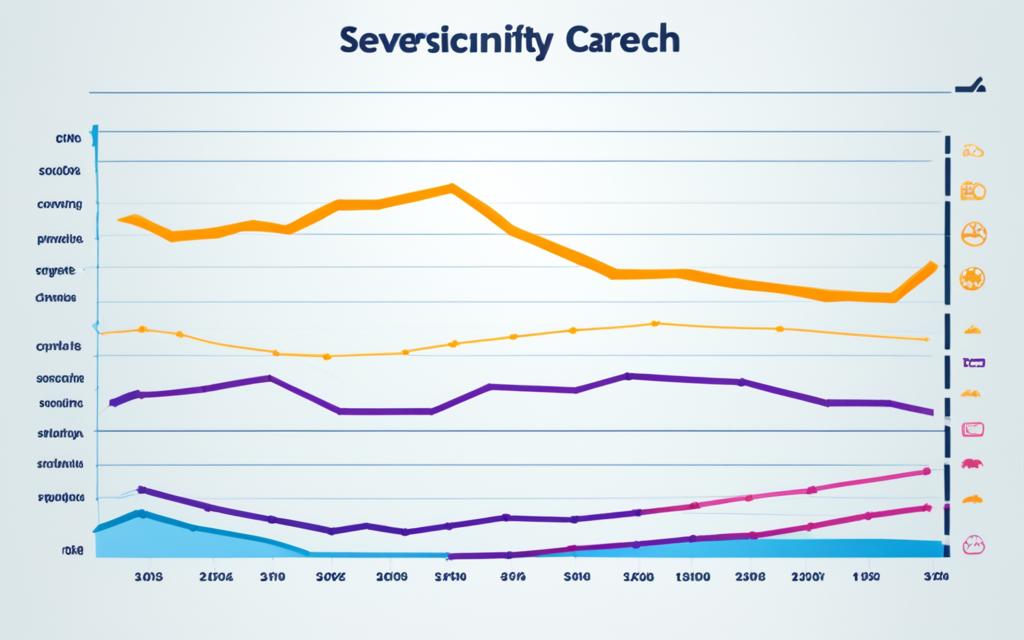Struggling with a damaged brand image? Discover how Reputation Return’s expert strategies can help you achieve brand reputation recovery and regain customer trust. This article dives into the brand reputation crisis by providing an eight-step process that you can follow to avert the crisis and rebuild your image. The first step is to assess the severity of the situation by quantifying changes in corporate reputation, employee and stakeholder perception, and online sentiment. Once you have a clear picture, you’ll need to communicate the impact of the crisis to key stakeholders and manage media relations to shape public perception.
Key Takeaways
- Understand the importance of proactive brand reputation management to mitigate the impact of crises.
- Learn how to effectively communicate with stakeholders and manage media relations during a reputation crisis.
- Discover strategies to empower employees and control online conversations to restore your brand’s image.
- Explore the benefits of partnering with a reputation restoration firm like Reputation Return to accelerate your recovery.
- Recognize the long-term value of rebuilding a strong, positive brand reputation for your business.
The Importance of Brand Reputation
In today’s competitive market, a brand’s reputation has become a crucial factor in determining its success. According to a survey by Deloitte, a staggering 88% of brand executives view reputation risk as a top strategic business concern. This statistic highlights the significant impact that a brand’s reputation can have on its overall performance and longevity.
Brand reputation refers to how consumers perceive a specific brand based on its image, values, and performance. A strong, positive reputation establishes trust, credibility, and loyalty among customers, while a negative reputation can tarnish a company’s image, causing it to lose credibility and sales. Firms with strong positive reputations often have higher price-earnings multiples and market values, as they are perceived as providing more value to their customers.
Intangible assets such as brand equity contribute to 70% to 80% of market value in the economy. Companies that manage their reputations well have more loyal customers who purchase a wider range of products and. In fact, 71% of consumers are more likely to make a purchase from a brand they trust, and companies with a strong brand reputation can charge a 9% price premium compared to competitors.
| Metric | Impact |
|---|---|
| Customer Loyalty | Companies with a strong brand reputation experience 33% higher customer loyalty. |
| Transparency | 94% of consumers are more likely to be loyal to a brand that offers complete transparency. |
| Social Media Engagement | 91% of consumers are more likely to engage with businesses that are active on social media. |
| Brand Advocacy | Brand advocacy can generate a 16% increase in average lifetime value (LTV) of customers. |
In conclusion, a strong brand reputation is essential for the success and growth of any business. By understanding the importance of reputation risk, companies can focus on building and maintaining a positive brand image, which can lead to increased customer loyalty, higher revenue, and a stronger competitive position in the market.
Assessing the Severity of the Reputation Crisis
When your brand faces a reputation crisis, the first crucial step is to assess the severity of the situation. This is where you take a step back and analyze the depth of the damage caused. To understand how serious the crisis is, you need to quantify changes in corporate reputation metrics, a downtick in perception among employees and stakeholders, and a negative attitude towards the company.
During the initial reputation crisis assessment, it is important to identify any executives or specific brand entities that are directly responsible for the event. Remember that the brand crisis is reflected online, so keep track of the situation on social media platforms as well as online reputation monitoring through Google search results.
A comprehensive understanding of the crisis’s impact is essential for devising an effective recovery strategy. By quantifying the damage, you can prioritize your response efforts and allocate resources accordingly. This approach ensures that your reputation management plan is tailored to the specific needs of the situation, increasing the chances of a successful recovery.
| Key Reputation Metrics | Potential Impact |
|---|---|
| Brand Perception | A significant decline in positive brand perception among customers, employees, and stakeholders can severely undermine trust and loyalty. |
| Social Media Sentiment | Negative sentiment on social platforms can amplify the crisis, making it challenging to control the narrative and restore brand image. |
| Search Engine Visibility | Unfavorable search results can dramatically reduce the visibility and trustworthiness of your brand, leading to a loss of potential customers. |
| Customer Retention | A damaged reputation can result in a decline in customer retention, as trust and loyalty are eroded, leading to a decrease in revenue and market share. |
By carefully assessing the severity of the reputation crisis and its impact on key metrics, you can develop a strategic and targeted response plan to mitigate the damage and pave the way for a successful brand recovery.

Communicating with Stakeholders
When facing a crisis, effective communication with your stakeholders is critical for safeguarding your brand’s reputation. As the first step, you must clearly convey the details of the crisis, its impact, and the measures you are taking to resolve the situation to your key stakeholders, including business partners, investors, customers, and other primary stakeholders.
Your ability to bring the company back into alignment rests on how well you can engage these crucial stakeholders. Transparency and timeliness are paramount in crisis communication. Provide a formal account of how events unfolded, leading to the crisis, and outline the specific actions you are undertaking to address the concerns.
Effective stakeholder engagement during a crisis involves:
- Acknowledging the crisis: Be upfront about the situation and its potential consequences.
- Providing accurate information: Share verified details and avoid speculation or misinformation.
- Demonstrating empathy: Show that you understand the concerns of your stakeholders.
- Outlining the recovery plan: Explain the steps you are taking to mitigate the crisis and prevent future occurrences.
- Maintaining transparency: Regularly update stakeholders on the progress of your crisis management efforts.
By proactively communicating with your stakeholders, you can regain their trust and confidence, positioning your brand for a successful reputation recovery. Remember, effective crisis communication, stakeholder engagement, and a robust reputation management strategy are crucial in navigating a reputational crisis.
| Stakeholder Group | Communication Priorities |
|---|---|
| Business Partners | Outline the impact on operations and collaborative efforts, and reassure them about the stability of the partnership. |
| Investors | Provide detailed financial information, projections, and a clear recovery plan to address their concerns about the crisis’s impact on the company’s financial performance. |
| Customers | Acknowledge the impact on their experience, offer solutions or compensation, and demonstrate a commitment to restoring their trust in the brand. |
| Employees | Ensure they understand the crisis, their role in the recovery, and how the company is supporting them through the challenging time. |
Managing Media Relations
Effective crisis PR management requires carefully orchestrating media relations. This is where brand leaders issue a public statement and select the right spokesperson to deliver it. While this may seem straightforward, navigating the court of public opinion can be challenging. Depending on the situation, you may need to acknowledge and own up to mistakes, firmly stand by your brand’s position, or seek a collaborative approach to address any misinformation.
Managing media relations is crucial for shaping public perception and regaining trust. PR professionals focus on crisis communication, media relations, stakeholder engagement, and reputation monitoring to handle adverse situations effectively. Transparency is highlighted as a critical factor in managing crises successfully, helping to create trust and limit damaging speculation and rumors.
Sincere apologies are noted as a vital step in reputation repair, showing humility and a willingness to fix issues, thus rebuilding the public’s confidence. PR specialists also emphasize positive storytelling to counteract negative publicity by showcasing the organization’s strengths, values, and community contributions.
Rebuilding relationships with customers, investors, and stakeholders is essential in reputation repair and long-term financial recovery. The role of PR in reputation management is paramount for crisis management, rebuilding trust, and ensuring the possibility of financial recovery.
Empowering Employees
During a reputation crisis, your employees can be your greatest allies in restoring your brand’s image. As the frontline representatives of your company, they have the power to shape perceptions and contribute to the recovery process. By empowering your employees, you can leverage their enthusiasm and dedication to alleviate the situation and proactively protect your brand.
Ensure Employees Understand the Crisis
The first step is to ensure that all employees comprehend the nature of the reputation crisis and why it occurred. Provide them with clear and transparent communication about the underlying issues, the steps being taken to address the problem, and the importance of their role in the recovery effort. When employees understand the context and the company’s commitment to resolving the crisis, they are more likely to become engaged and invested in the process.
Train and Incentivize Employees
Next, equip your employees with the necessary training and tools to actively contribute to the reputation-rebuilding process. This may include educating them on your reputation crisis management strategies, social media best practices, and effective communication techniques. Incentivize their involvement by offering rewards, recognition, or other forms of appreciation for their efforts in protecting the brand image.
By empowering your employees as brand ambassadors, you can leverage their employee engagement to mitigate the impact of the reputation crisis management challenge and restore your company’s standing in the eyes of your stakeholders.
| Key Benefits of Employee Empowerment | Potential Risks of Neglecting Employee Engagement |
|---|---|
|
|
Controlling Online Conversations
In today’s socially-driven world, over 65% of business leaders believe that social media can worsen a brand crisis. However, you can enhance the online reputation management process by taking control of your communication platforms. This means taking charge of conversations on your website, affiliated blogs, social media channels, review websites, and any other online platform.
Start by publishing a formal apology across all these platforms and track all hashtags and keywords that feature your brand. Respond swiftly to comments and maintain consistency in your messaging to proactively manage your social media crisis response. Continuously monitor your brand monitoring efforts to ensure a positive brand perception and customer trust.
- Publish a formal apology across all communication platforms
- Track relevant hashtags and keywords to monitor brand mentions
- Respond promptly to comments and maintain consistent messaging
- Continuously monitor and analyze your brand’s online presence
| Online Reputation Management Statistic | Percentage |
|---|---|
| Consumers who read online reviews before visiting a local business | 77% |
| Consumers who expect a brand to respond within 24 hours on social media | 79% |
| Buyers who do research on a search engine before making a purchase | 53% |

Effective online reputation management is a continuous process that requires ongoing monitoring, analysis, and proactive strategies to maintain a positive brand image and customer trust. By taking control of your online conversations, you can swiftly address any reputation issues and safeguard your brand’s reputation.
brand reputation recovery
In the aftermath of a reputation crisis, rebuilding your brand’s image is a crucial undertaking. The key lies in effectively managing your online content to suppress damaging information and proactively publish positive narratives. This comprehensive approach, known as reputation rebuilding, is essential for restoring trust restoration and reclaiming your rightful place in the market.
One of the primary challenges in reputation rebuilding is addressing the negative content that has already proliferated online. This may involve strategies such as content removal, suppression, and the strategic publication of positive content to outweigh the damaging information. Leveraging content management techniques can help you regain control of the narrative and reshape perceptions about your brand.
Transparency is also paramount during this process. Demonstrating a genuine commitment to addressing the underlying issues and fulfilling any promises made during the crisis can go a long way in rebuilding consumer trust restoration. Stakeholders and the public are more likely to forgive and support a brand that takes responsibility and transparently outlines its plan for improvement.
Effective reputation rebuilding often requires a multifaceted approach, encompassing search engine optimization (SEO), public relations, crisis management, and content creation. By strategically aligning these disciplines, you can systematically address the negative content, amplify positive narratives, and ultimately restore your brand’s reputation.
Remember, the path to reputation rebuilding is not a quick fix, but a sustained effort. With a well-executed content management strategy and a steadfast commitment to transparency and integrity, you can navigate the journey and emerge stronger than ever before.
Conclusion
Rebuilding your brand’s reputation after a crisis requires a solid strategy, strong commitment, and self-discipline. In today’s highly competitive world, some adversaries may always seek to see your brand falter. However, you shouldn’t let a single brand reputation crisis define your failure. Use the tips outlined in this article to get your brand’s reputation back on track and emerge stronger than before.
Remember, it’s not just about recovering from the current crisis, but also planning for the future to ensure a similar incident does not occur again. Amending internal processes, training employees proactively, and creating a robust reputation crisis management are some steps you can take to protect your brand in the long run and prevent future crises.
By implementing a comprehensive long-term reputation management strategy, focused on crisis prevention and a strong brand reputation, you can position your business for continued success and maintain the trust of your stakeholders, even in the face of adversity. The journey may be challenging, but with the right approach, you can emerge from a reputation crisis stronger and more resilient than ever before.

